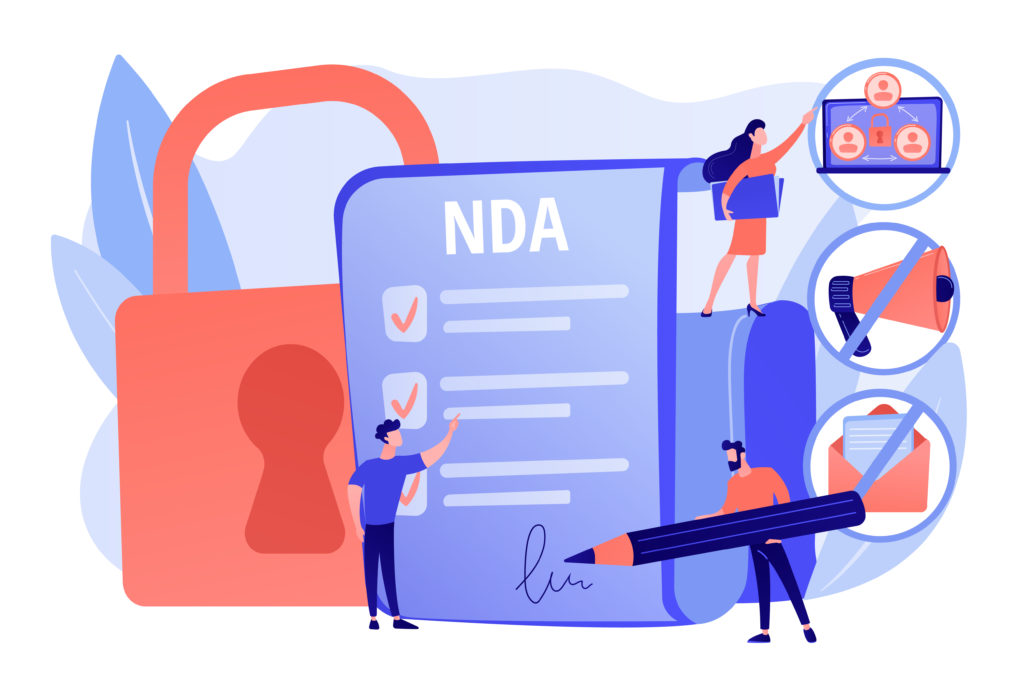Got no time to read? Listen to our blog on the go
In one of our previous posts, we discussed the differences between a contract and an agreement. However, this was just the tip of the iceberg. To develop a contract that fits your needs and legally protects all parties, you have to dive deeper and consider a lot of aspects. One of them is the contract type since not all contracts are the same.
In this post, we will take a closer look at the different types of contracts. We’ll also explain how to choose the option that will work best for you.
What Is a Contract?
A contract is an agreement between parties to do or not do certain things that is legally binding (i.e., creates legal obligations for parties) and enforceable (i.e., parties can be made to obey its terms). So, in general, a contract serves two main functions: clarifying the terms of an agreement and ensuring there will be legal consequences for not adhering to them.
A contract is an agreement between parties to do or not do certain things that is legally binding and enforceable.
For a contract to be legally binding, it needs to include the following elements:
- Offer & acceptance
- Mutual consent
- Consideration (i.e., value exchanged)
- Competence (i.e., parties’ capacity to sign a contract)
- Legal purpose
The absence of any of those elements means that a court can choose not to enforce a contract, meaning a party will not be protected by law if the other party fails to fulfill its contractual obligations. That’s why it is vital to consider the above elements when signing any contract.
But is signing a contract critical? Absolutely, yes! That’s what we’ll be talking about next.
Why Signing a Contract Is Important
While you may come to an agreement through negotiations, the final step should always be signing a contract. An agreement is simply the common intention of parties as to a certain course of actions. On the other hand, a contract will serve as proof that you and the other party have rights and are bound by obligations in respect to each other. Why do you need this?
It’s great if a person or a company that entered into an agreement with you is reliable and complies with all the obligations. But, unfortunately, that’s not always the case. You may need to take legal action against the other party to force it to meet the terms you agreed upon. Without a signed contract, it’ll be hard (or almost impossible) to prove to the court that your agreement ever existed and that your rights were violated.
So, signing a contract is essential. But choosing the right type of contract is also a crucial step in making everything work. So, let’s talk about the most common contract types used in business.
13 Most Common Contract Types for Businesses
Below we outline core types of business contracts that you might come across when operating a business. You probably won’t need to use all of them, but it’s always good to be informed and prepared.
Fixed-Price Contract
In a fixed-price contract, parties agree on the total payment in advance. This figure doesn’t depend on how many resources a contractor actually spends to perform the work. Here are the key characteristics of this contract type:
- A price estimate is made by the contractor based on assumed costs of material and labor needed to perform the action under the contract.
- Usually, a contractor includes some unexpected costs in the estimation to mitigate the risks.
- The estimation plays a crucial role in contract creation, so the whole process may be a bit long
- May include penalties for missing deadlines and/or bonuses for completing obligations early.
This type of contract is considered risky: if the estimation is wrong, either the buyer overpays or the contractor doesn’t cover the costs spent to perform the actions. But if initial estimations are made carefully, this option may turn out profitable for both parties.
Cost-Reimbursement Contract

In this type of contract or agreement, the final price is determined after a project or some of its stages are completed. However, a contractor estimates the costs before the start of the project, and the parties set a ceiling price. Without the buyer’s approval, this ‘ceiling’ can’t be exceeded. When it is reached, the parties need to decide on the next step.
The key characteristics of cost-reimbursement contracts include:
- The buyer reimburses the contractor for all incurred costs.
- If a ceiling price specified in the contract is reached, a buyer must approve further action, or the contractor can stop working on the project.
Construction is an area in which this contract is commonly used. It is less risky than fixed-price contracts, but, in some cases, it may be less profitable for the contractor, as they don’t get any extra payment, only being reimbursed for the labor and materials used.
Cost-Plus Contract
This type of vendor contract is similar to the cost-reimbursement type, with one important difference. The ‘plus’ refers to the extra money (contractor’s profit and overhead expenses) the buyer agrees to pay. Because the buyer is paying extra, they expect the project to be delivered on time. Key characteristics of a cost-plus contract include the following:
- A contractor provides an estimation of all costs in advance.
- A buyer can review the list of all potential expenses and usually knows what the price of the most-expensive scenario might be before the project starts.
- A buyer agrees to pay an extra fee on top of materials, labor, and time.
- A contractor is motivated to complete the project on time, not exceeding the ceiling price the parties agreed upon.
This option is appropriate to use when the exact cost estimates are difficult to make beforehand. It also gives the contractor flexibility to make changes after the start of the project. The contractors may also be rewarded for exceeding expectations, showing good performance, or with a fixed amount when the project is done.
Time and Materials Contract
As the name suggests, the buyer pays the contractor for the materials used and the time spent on the project. With this contract, it is crucial to track everything happening within the project accurately; otherwise, a contractor can miss the chance to get paid for some resources spent. Here are key characteristics of time and materials contracts:
- Materials and labor need to be paid for by the buyer.
- The parties agree on the price of the materials, the markup rate, and hourly rates when creating the contract.
- The contractor has a high level of flexibility if changes need to be made during the project.
These contracts work well in situations where it’s hard or impossible to estimate the scale of the project and the final costs in advance. Time and materials is also a common type of consultant contracts. Although they rarely imply the ‘material’ part, it’s convenient to determine a final price based on the number of hours a consultant actually spent to provide the services.
Unit Price Contract

In unit price contracts, the contractor provides the buyer with the cost of one unit required to complete the project. The units can refer to time or materials, but usually, one unit combines both elements.
For example, the buyer agrees to pay $300 for building one section of the floor in the house (materials plus associated labor). This creates one unit. It takes 20 sections to complete building the floor in the entire house. In this case, the buyer will end up paying $6,000 when the project ends. The key characteristics of unit price contracts are the following:
- The price per unit is specified in the contract.
- The buyer reimburses the contractor for the number of units spent on the project.
- The final price is determined upon the project’s completion.
This type of contract is easy to understand, so it’s a convenient option in many cases where work of some kind is performed.
Bilateral Contract
In this type of contract, the parties exchange something of value. It could be services, goods, or money. They both agree to provide something that’s valuable to the other party, as long as the other party does the same.
Basically, most contracts are bilateral: a contractor (seller, supplier) provides a buyer with products or services, and a buyer gives a contractor (seller, supplier) money. The key features of bilateral contracts include:
- An agreement between parties to exchange something of value.
- The contract is fulfilled if the buyer pays the money and the contractor (seller, supplier) delivers on the agreed-upon terms.
Bilateral contracts are types of contracts used in procurement and sales. They’re built on the understanding that each party can offer something that the other wants.
Unilateral Contract

In this contract type, one party (the offeror) agrees to pay the buyer only after (and if) a certain task is done or a particular event happens. For example, an offeror can create an open request (e.g., to pay $500 to anyone who will find their lost dog). Another typical case of a unilateral contract is an insurance relationship where the insurer agrees to pay the client if a covered event takes place. Unilateral contracts have the following key characteristics:
- The offeror has to pay only if someone meets certain conditions or some event happens.
- The offeror can face legal consequences for refusing to pay after the conditions have been met.
In general, unilateral contracts are less common than bilateral contracts. But, in some cases, businesses might need to use them.
Implied Contract
Implied contracts are an understanding between two parties, either agreed on or implied through actions. The interesting thing about them is that they’re usually not written down or discussed explicitly. Such contracts are divided into two types. One is called “implied-in-fact,” meaning that they occur when parties perform some actions. Meanwhile, the other is “implied-in-law,” meaning that the obligations of the parties are prescribed by legislative acts. The key characteristics of implied contracts include:
- They are usually not written down or even discussed by parties.
- They occur out of the actions of the involved parties or state laws.
Like unilateral contracts, you won’t see implied contracts very often in business activity. They might occur when, for example, a company buys something that has a warranty. But, in most such cases, the parties create a written contract anyway.
Express Contract

This is a broad type of business contracts. Basically, it covers any contract that, unlike implied contracts, is agreed on verbally or in writing. The terms are clearly expressed, and they need to include the six basic elements of a contract we’ve mentioned above (offer, acceptance, mutual consent, consideration, competence, and legal purpose).
Express contracts have the following key characteristics:
- Parties explicitly agree to be bound by the contract.
- Most often, express contracts are written and signed by the parties.
This type of contract is relatively easy to enforce. Proving the existence of said agreement in court isn’t hard. Either of the parties can prove that certain obligations weren’t met, if need be.

Simple Contract
This agreement can be verbal or written and doesn’t require a seal but is still legally binding. Employment and non-compete agreements are examples of simple contracts. Here are their key characteristics:
- This contract type isn’t officially sealed but is binding and enforceable.
- A breach of the contract can have legal consequences for a party that fails to perform contractual obligations.
Although simple contracts can be verbal, creating a written document is still recommended. This will simplify the protection of your rights if the other party doesn’t uphold their end of the deal.
Unconscionable Contract
To put it simply, this is an agreement that is unfair to one of the parties. It may be unfair for multiple reasons. One example of an unconscionable contract is when one party pressures the other party into signing the contract by leveraging their bargaining power.
Key characteristics of unconscionable contracts include:
- The contract is obviously one-sided and unfair.
- It isn’t enforceable, as the court may not accept it and rule it to be null.
As you see, this type of contract doesn’t protect your rights in case legal action needs to be taken. It’s important to make sure your agreement doesn’t meet the criteria of unconscionable contracts before signing it. It’s always better to be safe than sorry.
Adhesion Contract

The main feature of adhesion contracts is that they’re identical and don’t allow for negotiations. These contracts are often used when a seller offers typical terms for all its clients. So, a buyer can either enter a contract and agree to all its terms or refuse to enter the contract. Purchase of real estate can be an example of an adhesion contract.
Adhesion contracts have the following key characteristics:
- They don’t allow for bargaining; you either accept or reject all their terms.
- If you accept, you are obligated to uphold your end of the deal.
In this contract type, one party may have more bargaining power over the other. However, that doesn’t necessarily mean that the agreement is unfair. Just make sure the terms are clear to you and that you don’t feel pressured to accept. Actually, this goes for all contracts and is important to remember.
Aleatory Contract
Aleatory contracts are similar to unilateral contracts since the action is taken only after a certain event occurs. The difference here is both parties may be obligated to do something after said event.
Here are the key characteristics of aleatory contracts:
- The contract states the circumstances that need to happen for both parties to start performing their end of the deal.
- The triggering event may never occur, and neither of the parties can predict or control it.
The insurance industry is where you’ll usually come across this type of contract. Neither the insurer nor the client can predict the future, but both promise to fulfill their obligations in case a covered event takes place.
And that’s all! It does seem like a lot, but once you get the hang of the key points of every contract, it’s not hard to recognize them. Knowing the main characteristics of each type can help you choose the proper contract for your business deal.
Contract Types Comparison
Even if you know everything about the common types of contracts, it might be hard to see the big picture. The table below summarizes how the different contract types stack up with each other.
| Party 1 offers | Party 2 offers | Difficulties | Advantages | Typical application | |
| Fixed-price | A service + estimate of total costs | Covering the costs (the entire fixed price) | Accurately estimating final costs | Possibly bigger profit for Party 1 (a contractor), less hassle for Party 2 (a buyer) | Construction, manufacturing, engineering |
| Cost-reimbursement | A service + approximate estimate of total costs | Covering the costs (until the ceiling price is reached) | The project may not be finished if costs exceed the limit | Can be cheaper than fixed-price contracts, offers more flexibility | Construction, manufacturing, engineering |
| Cost-plus | A service + approximate estimate of total costs | Covering the costs + additional fee (contractor’s profit and overhead expenses) | It may turn out to be more expensive for a buyer than other contracts | Gives Party 1 (a contractor) more wiggle room and incentive; Party 2 (a buyer) gets exactly what they paid for | Construction, manufacturing, engineering |
| Time and materials | A service + hourly rates, price of materials | Covering the costs | Recording hours and materials | Flexibility and simplified negotiation process | Construction, software development, consultancy services |
| Unit price | A service + the cost of one unit | Covering the costs of all units | Estimating the number of units, unexpected unit price changes | Simple contract with clear terms | Construction, manufacturing, repair services |
| Bilateral | Services or goods that are of value to the other party | Services or goods that are of value to the other party | Both parties are the obligor and obligee at once | Both parties receive something of value to them | Sales, procurement |
| Unilateral | Services or goods that the other party requested, usually in an open request | Compensation | No room for negotiation | Simple contract with clear terms | Insurance |
| Implied | Services or goods | Performing an action such as buying a product | Can create misunderstanding | No need to write them down or sign; goes into action after a task is performed | Product warranties |
| Express | Anything | Anything | Needs to contain the six main elements of a contract | No room for misunderstandings; parties get what they expect | Most areas, including sales of goods, procurement, providing services |
| Simple | Something of value to the other party | Something of value to the other party | Agreement can be implied, which may create misunderstanding | Simple contract that is legally binding | Employment |
| Unconscionable | Anything | Anything | The contract is unfair to one party and will not be accepted in court | None | Any area |
| Adhesion | Services or goods | Payment | Lack of room for negotiations | Contracts are standard, clear, and easy to create | Insurance, real estate |
| Aleatory | Services or goods | Usually payment | An event can’t be predicted by either party; a contract might never be executed | Legally binding contract with clear terms | Insurance |
Phew! Looks like that’s about it! Hopefully, this simplified comparison will make it easier to remember their differences. Now, let’s move on to the most important part.
How to Choose the Right Contract Type
As we said earlier, many factors go into choosing the best type of contract for your deal. Now that you have an idea of the different contracts’ characteristics let’s look at a few aspects of selecting an option that will best fit your case. Here are the things you need to consider before creating and signing a contract:
- Price and cost analysis. You need to make calculations to estimate how profitable the deal would be for you. Are you sure that this contract type will provide you with the best options when it comes to costs or payment? Is there a better option that allows you to spend less while getting more?
- Contractor analysis. Is the other party trustworthy? How likely is it that your project will be finished on time? Do they have the necessary competence to do what you ask of them? Can you expect legal trouble? Make sure the type of contract you choose protects your rights and is enforceable.
- Type and complexity of the requirements. If the requirements are very complex with hard-to-estimate outcomes, you need to consider multiple contract types. This is common with government and research projects. Is one type of contract enough? Do you need to combine types to get the best result?
- Urgency of the requirements. If you urgently need something from the other party, you may choose a riskier type of contract. But make sure not to enter an unconscionable contract.
- Period over which the project will be completed. You need to know how long the whole thing will stretch out for. If the contract takes many years to fulfill, you need to carefully analyze the market and account for possibly significant changes.
Again, these are just a few important factors that need to be considered to choose the right contract. Knowing all of them comes with experience in the legal world because it might be hard to tell which factors are significant to your deal and which aren’t.
Bottom line
Reading about all the different contract types may make you feel intimidated. It is easy to get lost in all the information you need to know before even choosing the right type for your case. The good news is that creating legal documents for your business doesn’t always have to be complicated.
With the help of modern contract automation and contract lifecycle management (CLM) tools like AXDRAFT, you can easily create and edit all your contracts. You can draft documents automatically without hiring an entire legal team. All you have to do is answer a few simple questions.
Not sure if AXDRAFT is what you’re looking for? Take a minute to try the demo and get your first tailored document. Give it a shot, and see how easy it can be to create contracts!
Interesting Related Posts
- Commercial Contracts: What’s Inside and How to Manage Them
- Sales Contracts: Types and Components
- A Vendor Contract: Why, What, and How
- Agreement vs Contract: What’s the Difference?
- 7 Essential Elements of a Contract
FAQ
Some commonly used types of contracts include:
- Fixed-price
- Cost-reimbursement
- Cost-plus contract
- Time and materials
- Unit price
- Unilateral
- Bilateral
- Simple
- Implied
- Express
- Unconscionable
- Adhesion
- Aleatory
There is no ‘best’ contract. The type you choose needs to fit your needs and ensure that your deal is profitable and safe. After careful consideration, you can find the one that works best for you.
The elements that a contract needs to include are as follows:
- Offer and acceptance.
- Mutual consent.
- Consideration (i.e., value exchanged).
- Competence (i.e., parties’ capacity to sign a contract).
- Legal purpose.
These are the main stages of the contract lifecycle:
- Contract creation
- Collaboration
- Review
- Approval
- Signing
- Storage and analysis
- Obligations tracking